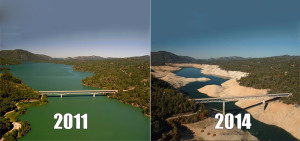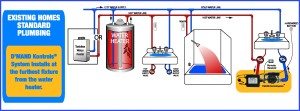Conventional plumbing systems waste water.
You turn on the faucet and wait until the water gets hot. During that time, cold water is being wasted and dumped down the drain.
Needless to say, wasting water is bad, especially right now in California. If you’re unaware of the severity of the drought, here’s an article every Californian should read.
 TL;DR: We’re not conserving nearly enough water. Governor Jerry Brown’s Executive Order will require a 25% statewide overall reduction in potable water use, focusing on, but not limited to, irrigation. Suppliers, businesses, and residents will all be held responsible. For failing to meet the new regulations, property owners will be fined up to $500 per day, and water agencies will be fined up to $10,000 per day.
TL;DR: We’re not conserving nearly enough water. Governor Jerry Brown’s Executive Order will require a 25% statewide overall reduction in potable water use, focusing on, but not limited to, irrigation. Suppliers, businesses, and residents will all be held responsible. For failing to meet the new regulations, property owners will be fined up to $500 per day, and water agencies will be fined up to $10,000 per day.
Standard recirculation systems waste energy.
You get your hot water immediately, because it’s sitting in the pipes waiting for you. But for the same reason, you’re wasting a lot of electricity. The pump runs 24/7, and the water heater continuously kicks on to reheat the water, which cools quickly sitting in the pipes unused.
How much energy do they waste? Well, the pump alone (which is much less significant than the water heater), at say 80 Watts, will use 700 kWh per year. That’s a little over $100 in California (assuming you’re in the lowest price tier on your electricity bill).
The water heater wastes a lot more (often in natural gas or propane), but the amount depends on the logistics of the building. Specifically, it depends on how far the water must travel, the total volume and surface area of the pipes, and whether the pipes are insulated. In this example, a resident has calculated about $400 per year in waste. This does not include the pump, and it is actual waste, not total use, because he has subtracted the amount of energy used with the recirc system off.
So, we’re looking at a ballpark of $500 per year of wasted energy from standard recirculation systems, not to mention the CO2 emissions.
Many also have systems that are set to activate on a programmable schedule. This may work for some with very regular schedules, but it still wastes a lot more energy than is needed.
Demand recirculation systems are a far more efficient way to distribute hot water.
How they work: Let’s say you are about to take a shower. You push a button located in your bathroom. This wirelessly turns on the pump which brings hot water to wherever the pump was installed (furthest room on the line that requires hot water). The pump senses when the hot water has arrived and automatically stops. The hot water is now in the bathroom’s pipes and ready for you to use. This all happens very quickly and all that is needed is to just push a button. Any number of wireless buttons can be installed anywhere around the house that will all activate this same pump when pushed.
Think of a conventional system, but imagine that instead of wasting the cold water, it preemptively sends that water back to the water heater, a short time before you need to use hot water.
Here are the options:
1. Motion sensor – the most convenient method, but possibly less efficient as it will likely turn on more often than you need it to.
2. Manual activation – push a wireless button as previously described.
 Demand recirculation systems are easy to install.
Demand recirculation systems are easy to install.
It is worth noting that, in new construction, efficiently designed plumbing is the most important factor for hot water distribution. The best way to conserve is to minimize the distance water travels, by locating the hot water fixtures near the water heater. That being said, unfortunately, most existing homes are not designed this way.
Demand systems can fit into existing plumbing scenarios without much difficulty. For example, they can be installed under your bathroom sink (this is commonly done, since the bathroom is often the furthest room from the heater). This makes them ideal for quick, minimally invasive retrofits. For homes that already have standard recirculation pump systems then in order to upgrade to this new Demand system one would install the new pump near the water heater as it would need to replace the one that is already there. They are also ideal for remodels or additions to a home that require a distant water fixture. The D’MAND Kontrols® system (see image), made by Advanced Conservation Technology inc., is a prime example of convenience, efficiency, and flexibility.
[dropshadowbox align=”none” effect=”lifted-both” width=”640px” height=”” background_color=”#ffffff” border_width=”1″ border_color=”#dddddd” ]For more information, call (925) 363-4498 or e-mail info@epbuilders.com to speak to a technician, or schedule an energy audit.[/dropshadowbox]

Speak Your Mind